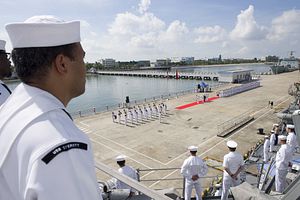The U.S. Navy Arleigh Burke-class guided missile destroyer USS Sterett arrived in Zhanjiang, China this week for a scheduled port visit, the U.S. Navy announced on Monday.
The U.S. warship arrived in the port city on June 12. Zhanjiang is home to the headquarters of the People’s Liberation Army Navy’s (PLAN) South Sea Fleet, responsible for Chinese naval operations in the South China Sea. The majority of the fleet’s surface combatants are stationed at Zhanjiang naval base, while the South Sea Fleet’s submarine force is located at Yulin naval base on Hainan Island.
The port visit will primarily consist of low-level interactions between U.S. Navy and PLAN personnel. “During the course of the port visit, sailors will conduct sporting events, ship tours, and a community relations event, along with leadership office calls and receptions with the PLAN,” the press release notes. “This visit is an exciting opportunity to promote maritime cooperation and reinforce a navy-to-navy relationship with our People’s Liberation Army Navy counterparts,” said Commander Claudine Caluori, the USS Sterett’s commanding officer.
The visit of the guided-missile destroyer is the first visit by a U.S. warship to mainland China in 2017. It also is the first time a U.S. Navy ship has visited Zhanjiang since 2015.
The USS Sterett recently operated in the South China Sea and held a training exercise with two B-1B Lancer heavy strategic bombers in the disputed waters on June 8. As I reported earlier this week, the two U.S. bombers flew on a ten-hour training mission over the South China Sea and operated in conjunction with the USS Sterett.
“The joint training, organized under Pacific Command’s continuous bomber presence program (CBP), allows the Air Force and Navy to increase interoperability by refining joint tactics, techniques, and procedures while simultaneously strengthening their ability to seamlessly integrate their operations,” U.S. Pacific Command said in a statement last week.
As I reported yesterday, China is carefully watching U.S. military activities in the South China Sea:
China said that it remains vigilant as the United States is stepping up its military presence in the disputed waters. “China always maintains vigilance and effective monitoring of the relevant country’s military activities in the South China Sea,” China’s Ministry of Defense said in a statement on June 9, referring to the B-1B training flights. “China’s military will resolutely safeguard national sovereignty, security and regional peace and stability,” it added.
The USS Sterett and the Littoral Combat Ship USS Coronado along with ships of the Republic of Singapore Navy and the Royal Thai Navy completed a three-day multilateral Cooperation Afloat Readiness and Training (CARAT) exercise in the South China Sea in May. The USS Sterett also participated in the International Maritime Defense Exposition 2017 in Singapore during the same month.

































